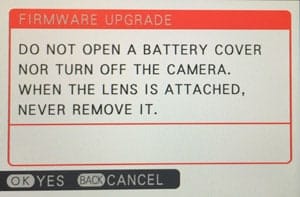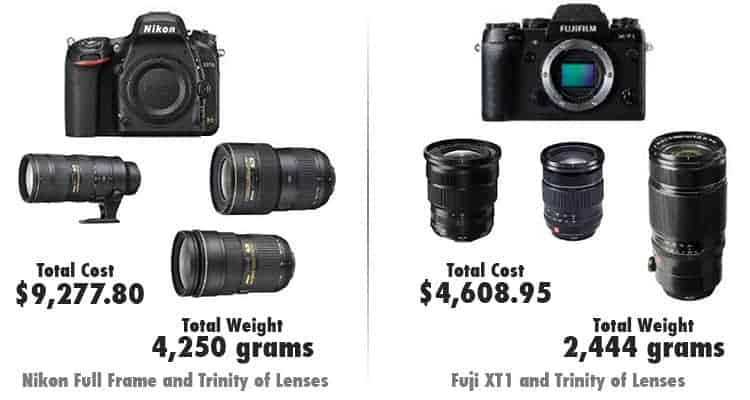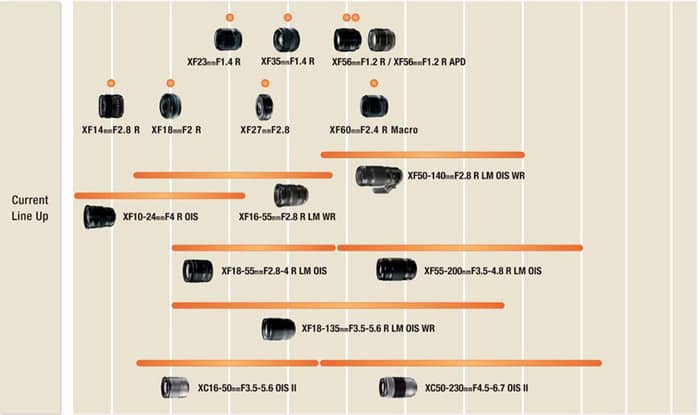I've shot with Nikon gear for the last several years, owning several crop sensor and full frame bodies. The Nikon D800 and D810 have been my favorite cameras for years. But I can't stand shooting with them anymore, and I'm moving to the mirrorless Fuji Xt1 and selling my Nikon gear. Stay tuned to Improve Photography next week because I'm having a HUGE garage sale of my Nikon gear, old tripods for big heavy cameras, camera bags for fat cameras, and other “obese camera” accessories.
In short, the Nikon gear is too heavy, too expensive, and lagging too far behind in innovative features. My new Fuji gear is half the weight, half the price, and is packed full of innovative features.
So goodbye Nikon, and hello Fuji (and no, nobody paid me to say that)!
Why I've HAD IT with Nikon!
On a recent trip to Chicago (see the Chicago photo tips video here) where I was speaking at a conference, I packed only a very basic kit of camera, tripod, 3 lenses for a day of shooting around the city. My bag weighed 15.5 pounds (7 kilos). That's heavy enough to make photography not fun when you're shooting in over a dozen locations around the city in one day and walking to all of them (we did 24,000 steps that day!).
But it's not just about the whirlwind, insane photography shoots. Last night I took my wife and kids out on the boat and I actually brought a decent camera with me! The Fuji is light enough and small enough that I bring it everywhere with me. I realized yesterday that I've only once brought my Nikon out on the boat, and that was for a serious shoot. As we were driving home there was an incredible rainbow and sunset and I actually had a camera with me to get the shot.
And then there's price. My Nikon D810 cost over $3,000. I used it for less than 200 shots and then a TINY amount of water splashed up on it. The camera was entirely fried beyond repair (and that's not the ONLY “weather sealed” camera I've busted). That was a $3,000 mistake, whereas if I was doing the same shoot with a Fuji it would have cost me only $1,100. The other part of this is that my job is to teach photography full time by writing here on Improve Photography. The full frame Nikon gear and pro lenses is so incredibly expensive that few readers can really afford it, whereas the Fuji gear fits in many budgets.
The last reason I'm tired of Nikon is that they are innovating too slowly. In fact, my cell phone (which costs less than 1/3 the cost of a Nikon camera) has a ton of features that my Nikon doesn't. Obviously I'm not going to do serious photography with my iPhone, but it does make me wonder why an iPhone has a much much higher resolution screen, bigger battery, faster frame rate, touch screen, bluetooth, a clock that sets itself to the right time, higher frame rate video, wifi, nfc, and other features that my $3,000 professional camera doesn't.
Why I Love the Fuji XT1
I've used the Fuji Xt1 in the past, and I commented on the Improve Photography Podcast (our free weekly audio show that you can subscribe to with one click here) that the Fuji XT1 is the funnest camera I've ever shot. But I didn't buy one because the autofocus just wasn't good enough for my work.
But the cool thing about Fuji is they aren't just spewing out a new camera every couple months. They are releasing a decent camera and then continually improving it with FREE firmware updates. Two weeks ago, Fuji released version 4 of its firmware and it's absolutely awesome. It brought the autofocus speed to a good enough level that I can now use it as my primary camera. It's incredible. It's a big enough upgrade to the firmware that it feels like a completely different camera, and they gave it to everyone who has purchased the camera for free. No longer do you have to buy a camera and have it feel outdated 6 months later, because they are constantly shipping upgraded features via the firmware.
My favorite thing about shooting Fuji is that it has a dial and button for everything! It has SIX customizable function buttons! It also has a separate dial for aperture on the lens, a separate dial for the shutter speed, and a separate dial for the ISO. The way Fuji has implemented this in the camera is really creative and works remarkably well. Each dial has an “A” for auto, so if you want to shoot in aperture priority mode, you just set the aperture, set the ISO, and then put shutter speed at “A.” There is no mode dial. This makes setting the exposure very easy, because you don't have to even choose what mode you're in. You just set what you want to set and leave other settings in auto. It's absolutely beautiful, and it's my favorite feature of the Fuji cameras. I have no idea why other camera manufacturers haven't followed suit. Oh yeah, it's because Canon and Nikon refuse to innovate.

Why I Prefer the Fuji XT1 to my Nikon D810
- Half the weight
- Half the cost (XT1 costs about $1,100, and the D810 costs about $3,000)
- Faster frame rate (8fps on the XT1, 6 on the D810)
- After I take a photo, I get to see the playback of the photo right in the viewfinder, which completely eliminates chimping and means I can actually see the photo even when it's bright outside
- I can get GPS coordinates on my photos by syncing my phone's GPS to the camera
- The XT1 has wifi and the D810 doesn't
- Flip out LCD on the XT1, old school fixed LCD on the D810
- The XT1 has much better exposure controls with a dial for each player in the exposure triangle
- Fuji's lens trinity all have optical image stabilization (Nikon's 24-70 and 14-24 don't have image stabilization)
- Focus peeking
- On the Fuji XT1 you can easily set the max and minimum shutter speed, the max and minimum ISO for shooting in semi-manual modes
- I can see the histogram right in the viewfinder while shooting on the XT1
- FIRMWARE UPGRADES!
- I can see in the viewfinder when the lens is focused to infinity (very handy for landscape photographers!)
- Focus assist zoom to check critical focus in the viewfinder
- Much improved removable accessory flash
- There are six customizable function buttons so I can set the camera up exactly how I want it
- ISO bracketing (sometimes useful for HDR)
- Sweep panorama
- I like the look of the files straight out of the camera better than Nikon. The raw files come straight out looking a lot more like a Canon file does.

What About Resolution, Autofocus, and Low Light Performance?
You could also make a list like the one above with features where the Nikon D810 is better than the Fuji XT1 (phase detect AF points is a big one, as well as resolution). I realize that.
When I draw out a “pros and cons” list for keeping the Nikon or switching to Fuji, the Nikon always outweighed mirrorless because the image quality is so good. But with the recent firmware update, the autofocus on the XT1 got good enough that it tipped the scales for me.
I definitely miss having 36 megapixels. Resolution is my biggest complaint on the XT1. The Fuji XT1 is a 16 megapixel camera, and my iMac 5k is 14.7 megapixels. So if I do anything other than a very small crop, the photo doesn't fit my screen anymore. But then again, what's the last time someone other than myself saw a photo at FULL resolution on a 5k screen? It never really happens because the photos get squished down to tiny sizes when they are shared online, and 16mp is plenty for printing even quite large photos.
Autofocus on the XT1 is not as good as on a Nikon DSLR. The version 4 firmware released two weeks ago puts it light years ahead of where it was, but it still can't compare to a DSLR's autofocus. But after I gave it a week or so, I found that I had learned to shoot with the AF system on the Fuji and can now get reliable AF results. I even tested pretty fast motion several times and found that it did a pretty decent job. It's not the right camera for shooting an NFL game, but it'll do just fine for most wildlife photography (not flying birds), moderate action, and portraits of kids.
My last concern was low light performance. You can search online and see tons of side-by-side comparisons of the XT1 vs DSLRs, but I'll summarize this argument with my personal experience. I went out with the Fuji in very low light and shot at 1600, 3200, and 6400 ISO. When I got back to the computer and zoomed in to see how it did, my first thought was “What is everyone complaining about?!?!?” The XT1 was not much different in low light performance than my super expensive and heavy D810. It's just not worth worrying out.
In terms of pure resolution, the Nikon D810 kills the Fuji XT1. Murders it. Side-by-side you'll get a more slightly technically perfect photo with the D810. But I kept missing photos on my Nikon because I didn't bring it with me because it's so big and bulky. And I kept missing shots because I didn't bring all my lenses with me. And I kept missing opportunities to share my photos because it doesn't have wifi. Etc. Etc.
My experience with the Fuji so far is that I'm making more and better pictures with it for the reasons I've mentioned. Obviously, if I thought I would end up with better pictures with the Nikon, I would never have switched. Photography is my livelihood, so I can afford to get this wrong.
Isn't it Expensive to Switch Camera Systems?
Nope! I actually earned a few thousand dollars by switching to Fuji. Why? Because the price of selling all my super expensive Nikon gear is much higher than the cost of buying all new equivalent Fuji cameras and lenses. In fact, my spreadsheet tells me that once I sell my Nikon gear I'll be $3,346 ahead, and I'll have the exact same equivalent gear on Fuji. Isn't that awesome!?!?
I really don't care if you switch to a mirrorless camera or not. This isn't a crusade or anything, but I will say that it's worth checking to see if you could switch to mirrorless without even losing any money. I'd recommend buying a Fuji XT1 on Amazon and trying it out for a few weeks (after installing the firmware) and see if it's something you like. If it isn't, return it and keep your gear. But if you're like me, you'll get the camera and find it so lightweight and fun to shoot that you won't want to pick up the DSLR beast anymore. You should also try Panasonic, Olympus, and the Sony A600, which are all good options.
What About the Lens System?
I'm really impressed with Fuji's lens lineup. They have a very nice fast wide angle which is good enough for me to use as I travel the world shooting landscapes. I have no concerns about shooting the 10-24mm f/2.8 in my professional work.
Portrait photographers will be relieved to find the 16-55mm f/2.8 (equivalent to 24-70) and the 50-140 (equivalent to 70-200) are both excellent. Fuji also makes a 56mm f/1.2 (equivalent to an 85mm prime) that gets rave reviews, but which I haven't tried yet.
The real hole in the lens system right now (and also with most other mirrorless systems) is on the supertelephoto side. However, Fuji publishes a lens roadmap so you can see what is coming up. They are scheduled to come out with a 100-400mm in the first half of 2016. That will make Fuji a very compelling option for just about any photographer.
Fuji makes lenses that pro photographers will be happy with, and charges a lot less for them. Love that!
Other Mirrorless Cameras I Considered
The choice for me was really between Sony, Fuji, Panasonic, and Olympus. Those are the leading mirrorless camera manufacturers. I initially pre-ordered a Sony A7RII, but realized that I was just trading one heavy, expensive camera for another. I also considered the Sony a600, which is meets the lightweight and inexpensive criteria, but totally fails on autofocus (on my good buddy Darin Mellor‘s recommendation).
Click here to see my Top 10 Recommended Mirrorless Cameras Under $1,000.
Next, I tried the Olympus and Panasonic cameras, which are both Micro 4/3 and spent a good amount of time talking with pro shooters who use those systems as well as reps from the companies. I'm just not sold on the micro 4/3 system. It's too big of a jump to go from a full frame camera that I'm used to, clear down to a 4/3 sensor. The APS-C (“crop sensor”) format of the Fuji was more of a middle ground for me, and seems to do much better in low light in my tests. I was also quite concerned when the Panasonic rep had to reset the camera 3 times in our 20 minute conversation because the camera kept having weird bugs.
Come On, Jim. They're Paying You to Say This, Right?
Nope (although I wouldn't mind if they sent me a little ching ching 🙂 ) . I don't even know anyone at Fuji. They are just awesome at making camera gear.
The only reason I'm switching is because I like the gear and feel like I will get more and better photos with the Fuji than my Nikon–period. If I didn't feel like the image quality was good enough or anything else, there is no way I'd make the change.
Recommended Gear for Switching to Fuji
Fuji XT1 Camera with 18-135mm lens I’d recommend getting this combo of camera/lens because you get a discount on the 18-135. The 18-135 is a good general all-purpose lens for hiking, going out with the family, etc. After you get your camera in the mail, you'll go to the Fuji website and download the free firmware onto a memory card, put it in the camera, and do the upgrade. POOF! You have a brand new camera with all the latest and greatest features.
Fuji 10-24 f/4 This is the best wide angle lens available for Fuji. Good lens.
Fuji 50-140 f/2.8 This is the equivalent to a 70-200. Because of the crop factor, it makes this a 70-200 equivalent focal length.
Fuji 16-55mm f/2.8 This is equivalent to a 24-70. Probably the best lens for closer portraits, and full body shots.
Extra batteries You’ll want a bunch. With the OLED viewfinder, the camera chews through batteries quickly. These have a higher mAh count than the batteries that come with the Fuji, so they’ll last just a little longer, plus it gives you an extra charger and a car charger.
Be sure to check on the right hand side of the listing pages on Amazon for used gear. With cameras there are TONS of returns because people want to try out a camera before deciding, so you can often find a brand new lens that was just returned and get $200 off for it. I always pick the “like new” in the used section if I can find it.
About Jim Harmer
I'm the founder of ImprovePhotography.com, one of the largest photography education sites in the world. Millions of photographers visit the site, and nearly a million photographers have followed Improve Photography on social media. Our largest following is on Facebook, but I'm just starting to get a lot more involved on my Instagram profile, which I really enjoy and regularly follow back people who comment on my stuff.
I also host a free weekly audio podcast called the Improve Photography Podcast. It's a 40-minute audio show where I chat with Darin, Erica, Brian, and Jeff about the photography tips and gear we're learning and using. If you subscribe on iTunes, the show automatically downloads to your phone each week so you can listen as you commute, exercise, shop, or work. It's completely free, and we also have 3 other photography tips shows each week on the Improve Photography Network that you can subscribe to.
You can see my portfolio here.




Please keep the comments civil. People tend to freak out about camera brands. You’re welcome to disagree, but civilly!